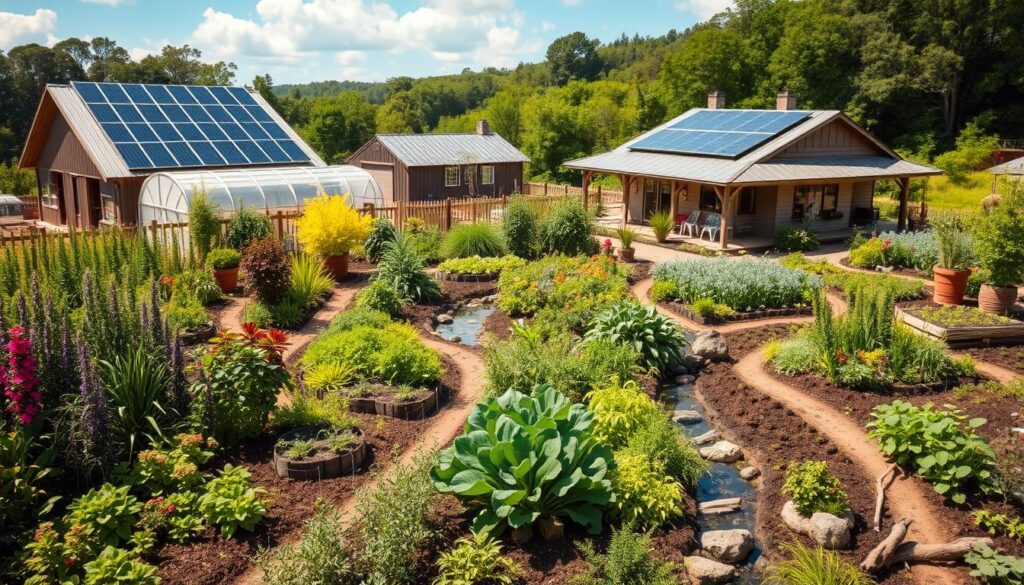What makes a permaculture business thrive in the long run? It’s about finding a balance between making money and caring for the environment. This balance is key for a business to grow and stay true to its ecological values. By focusing on making a profit, permaculture businesses can grow and help the planet at the same time.
Key Takeaways
- Permaculture businesses must prioritize profitability to achieve long-term sustainability and growth.
- A balanced approach considering both environmental and financial aspects is essential for permaculture business sustainability.
- Permaculture integrates ethics and sustainable management practices, emphasizing multi-faceted interactions within ecosystems.
- The Permaculture framework includes three guiding principles that promote functioning with nature rather than against it.
- Traditional resource management models have been deemed inadequate for sustainable resource management, highlighting the need for more integrated models like Permaculture.
- Permaculture aims to achieve a balance of ecosystem services that underpin human life, addressing the competing demands for natural resources amidst growing urbanization and population pressures.
- By adopting sustainable permaculture practices, businesses can contribute to a more environmentally friendly and socially responsible future.
Understanding Permaculture Business Metrics
Permaculture business metrics are key to knowing if an eco-friendly permaculture business is doing well. They show how the business affects the environment and help make smart choices. By using permaculture, businesses can grow their profits and help the planet.
The 12 principles of permaculture guide sustainable businesses. They teach us to observe nature, use energy wisely, and get a good return. These rules are vital for a thriving eco-friendly permaculture business.
Definition of Permaculture Metrics
Permaculture metrics measure how well a permaculture business is doing. They look at things like money made, profit, and how happy customers are. By watching these numbers, businesses can spot what needs work and get better at being green.
Importance of Metrics in Business
Metrics are crucial for any business, including those that are eco-friendly. They give insights into how well a business is doing and help owners make smart choices. By keeping an eye on things like money and customer happiness, businesses can find ways to be greener.
Overview of Key Performance Indicators (KPIs)
KPIs help measure the success of permaculture businesses. Some important ones are:
- Revenue growth
- Profit margins
- Customer satisfaction
- Environmental impact
By watching these KPIs, eco-friendly permaculture businesses can see how they’re doing. They can then make changes to be more sustainable.
Financial Metrics for Permaculture Enterprises
Permaculture businesses focus on organic sustainability initiatives and regenerative business practices for long-term success. They manage their finances well to thrive. This means tracking money coming in, spending wisely, and keeping profits high.
They also use regenerative business practices to support organic sustainability initiatives. This includes using renewable energy, cutting down on waste, and farming sustainably.
Revenue Streams in Permaculture
Permaculture businesses make money in different ways. They sell organic food, products made from it, and offer workshops and consulting. Having many ways to make money helps them stay stable.

Expense Tracking and Management
Keeping track of expenses is key for permaculture businesses. They watch costs like labor, materials, and equipment. They also find ways to use resources better and cut down on waste.
Profit Margins in Sustainable Practices
By focusing on organic sustainability initiatives and regenerative business practices, permaculture businesses can keep profits up. They invest in sustainable methods that save money and work better, like renewable energy and sustainable farming.
Yield Measurement in Permaculture
Permaculture business sustainability focuses on getting a yield. This means making changes and seeing results. It’s key to knowing if sustainable permaculture practices work.
Measuring yields helps permaculture businesses see how well they’re doing. They can use this info to get better at what they do.
Important parts of yield measurement in permaculture are:
- Determining crop yields to optimize resource allocation and minimize waste
- Assessing soil health and fertility to ensure long-term sustainability
- Measuring biodiversity impact to promote ecosystem services and resilience
Using sustainable permaculture practices brings many benefits. Businesses can work more efficiently, have healthier soil, and support more biodiversity. As people care more about the environment, they want sustainable products. This makes permaculture business sustainability very important for any business plan.
Customer Engagement Metrics
For an eco-friendly permaculture business, customer engagement is key. It builds a loyal community, vital for growth and success. Green business sustainability depends on it, as it lets businesses understand and meet customer needs.
Some important customer engagement metrics include:
- Customer acquisition: This is about getting new customers. It’s tracked by counting new customers over time.
- Customer retention: This shows how well a business keeps its customers. It’s measured by the percentage of customers who stay over time.
- Customer satisfaction: This is how happy customers are with the business. It’s tracked through feedback and reviews.
By monitoring these metrics, a business can learn what customers want. This knowledge helps improve engagement and grow the business. It also supports green business goals, helping create a more sustainable future.

| Metric | Description | Importance |
|---|---|---|
| Customer Acquisition | Attracting new customers to the business | High |
| Customer Retention | Retaining existing customers | High |
| Customer Satisfaction | Measuring customer satisfaction with the business | High |
Marketing Effectiveness Metrics
When looking at permaculture businesses, marketing metrics are key. Tracking things like campaign success, social media engagement, and how well promotions work helps. This way, businesses can fine-tune their marketing to connect better with their audience. It also helps in promoting regenerative business practices.
In the world of ethical permaculture entrepreneurship, good marketing is vital. It helps spread the word about sustainable practices and gets more people involved. Important metrics include:
- Campaign performance: tracking the success of marketing campaigns in terms of reach, engagement, and conversion rates
- Social media engagement analytics: monitoring social media metrics such as likes, shares, and comments to gauge customer engagement and sentiment
- Conversion rates from organic farming promotions: measuring the effectiveness of promotions in driving sales and revenue
By looking at these metrics, permaculture businesses can learn a lot. They can see what’s working and what’s not. This helps them make better choices and promote regenerative business practices. It also helps the business grow, makes customers happier, and supports a more sustainable and ethical permaculture entrepreneurship scene.
| Metric | Description |
|---|---|
| Campaign Performance | Tracking the success of marketing campaigns |
| Social Media Engagement Analytics | Monitoring social media metrics to gauge customer engagement and sentiment |
| Conversion Rates from Organic Farming Promotions | Measuring the effectiveness of promotions in driving sales and revenue |
Operational Efficiency Metrics
For permaculture businesses, using holistic sustainability strategies is key. This approach helps cut down on environmental harm. By being eco-friendly, they can use resources better and cut down on waste.
Looking at how well a business runs is important. This includes how much resources are used, how productive workers are, and how efficient the supply chain is. For instance, a farm can save water by using smart irrigation and collecting rainwater. This is shown on permaculture practice websites.
Permaculture businesses also gain by using renewable energy more. They can switch to solar or wind power and use energy-saving tech. This move helps them lower their carbon footprint and support a greener future.

Some interesting facts about permaculture businesses’ efficiency include:
– Up to 50% less resource use with refurbishment and remanufacturing.
– 20-30% lower energy costs with energy-saving tech.
– 30-50% less carbon footprint with renewable resources.
– 50-80% less packaging waste with eco-friendly packaging.
| Metric | Target Value |
|---|---|
| Crop Yield per Acre | 1,500 lbs |
| Soil Health Index | 80/100 |
| Water Usage Efficiency | 95% |
Environmental Impact Metrics
Permaculture business sustainability focuses on reducing environmental impact. It tracks carbon footprint, water usage, and waste reduction. By using sustainable practices, businesses can lessen their ecological footprint and help the environment.
Some important environmental impact metrics include:
- Carbon footprint assessment: measures greenhouse gas emissions
- Water usage tracking: keeps tabs on water used in farming and operations
- Waste reduction metrics: tracks waste and finds ways to cut it down
Adopting sustainable permaculture practices helps businesses reduce their environmental impact. This not only helps the planet but also boosts the business’s image. It attracts customers who care about sustainability.
| Metric | Description |
|---|---|
| Carbon Footprint | Measures the amount of greenhouse gas emissions produced by the business |
| Water Usage | Monitors the amount of water used in farming and other operations |
| Waste Reduction | Measures the amount of waste produced and implements strategies to reduce it |
Community and Social Metrics
For an eco-friendly permaculture business, community engagement is key. It’s about building strong ties with the local community and encouraging social responsibility. This approach, as seen in the permaculture and climate justice connection, leads to a greener business model.
Measuring volunteer participation is important. You can track volunteers, their hours, and the impact of their work. For example, events like the ChoZen Artisan Market in Sebastian, Florida, help build community and support eco-friendly businesses.
Understanding Community Engagement
Community engagement creates a sense of belonging. It’s done through workshops, events, and incubator programs. The Climate & Innovation HUB, for example, hosts events on climate resilience, showing the value of community involvement in green business.

Measuring Volunteer Participation
Tracking volunteer participation shows the community’s impact. You can count volunteers, their hours, and tasks. By focusing on community stewardship, eco-friendly businesses promote social responsibility and a sustainable future.
Innovation and Growth Metrics
Permaculture businesses do well when they focus on innovation and growth. They stay ahead by using regenerative business practices. Ethical permaculture entrepreneurship is vital for growth and innovation.
Tracking New Product Development
New product development is key for permaculture businesses to lead. Investing in research helps create innovative products. This meets the changing needs of customers, like new sustainable agriculture practices or eco-friendly products.
Measuring Investment in Research
It’s important to measure research investment to see returns. Tracking research costs helps find ways to improve. This leads to better efficiency and lower costs.
Analyzing Market Trends and Adaptation
Permaculture businesses must keep up with market trends. Analyzing trends and adapting helps them stay competitive. This includes using new technologies or entering new markets.
- Tracking industry trends and developments
- Analyzing customer needs and preferences
- Identifying new business opportunities
By focusing on innovation and growth, permaculture businesses can succeed. Adopting regenerative practices and ethical entrepreneurship helps them thrive in a changing market.
Technology Utilization Metrics
Permaculture businesses aim to use holistic sustainability strategies. They also look at how technology can help. By using tech, they can make their environmentally conscious business model better. For example, tech and permaculture together can manage resources better and cut down waste.
Technology can really help in a few key ways:
- Seeing how agricultural tech affects permaculture
- Making data collection faster for better decisions
- Figuring out if tech investments pay off in permaculture
By using technology, permaculture businesses can reach their sustainability goals. They can help the environment more. This leads to a better holistic sustainability strategy and an environmentally conscious business model.
Risk Management Metrics
Effective risk management is key for permaculture business success. By looking at business risks, permaculture companies can spot threats early. They can then plan how to lessen these risks. This includes checking insurance, handling legal issues, and making backup plans.
Permaculture businesses deal with risks like climate change and market shifts. They use self-regulation and listen to feedback to stay flexible. This way, they keep their environmental focus while staying financially stable.
Some important risk management metrics for permaculture businesses include:
- Looking at climate risks like droughts or floods and finding ways to lessen their effects
- Checking market risks like demand or price changes and adjusting their marketing plans
- Keeping an eye on new laws and making sure they follow them
By focusing on risk management and sustainable practices, businesses can lower their environmental impact. They become more resilient and help make the food system more sustainable.
Long-term Sustainability Metrics
For an eco-friendly permaculture business, it’s key to follow green business practices. This means checking if practices last, how long crops grow, and the health of ecosystems. It also means caring for the environment and being socially responsible.
Studies show permaculture sites have better soil health. They have more carbon, nitrogen, and phosphorus than regular farms. This is good for the planet and helps reduce harm to the environment.
- 27% higher carbon stock in the soil
- 63% higher total nitrogen concentrations
- 41% higher phosphorus levels
- Improved water retention and soil health
By using these green practices, a permaculture business can last long. It helps make the world a greener place and supports eco-friendly goals.
Employee Performance Metrics
In permaculture businesses, tracking how employees do is key to success. By using regenerative business practices, companies can make work better and more productive. They focus on training, job happiness, and how often people leave.
Tracking Training and Development
It’s important to keep an eye on how employees grow. By helping them learn and improve, businesses get better and make their workers happy. This fits with permaculture’s values of caring for people and the planet.
Evaluating Job Satisfaction
Checking if employees are happy at work is crucial. Knowing what they need helps make a better work place. This makes everyone happier, keeps people from leaving, and boosts performance.
Measuring Employee Turnover Rate
Watching how often people leave is important. It shows where to get better and how to keep workers. This saves money, boosts productivity, and keeps a team of skilled people.
Legislative and Compliance Metrics
Permaculture businesses must follow the law and be environmentally conscious. They need to know the rules, track their compliance, and measure their environmental impact. By using holistic sustainability strategies, they can reduce risks and support sustainability.
Tracking environmental compliance is crucial. Businesses can do this by conducting regular audits and assessing their environmental footprint. Here are some important metrics for measuring environmental compliance:
| Metric | Description |
|---|---|
| Carbon Footprint | Measure of the business’s greenhouse gas emissions |
| Water Usage | Measure of the business’s water consumption |
| Waste Reduction | Measure of the business’s waste reduction efforts |
By monitoring these metrics, permaculture businesses can stay in line with the law and be environmentally conscious. This approach not only reduces risks but also supports holistic sustainability strategies. It helps create a more sustainable future.
After-Action Review Metrics
Regular reviews are key for permaculture businesses to spot areas for betterment and keep learning. This step involves looking back at past actions, studying data, and making changes to boost sustainable permaculture practices. It helps businesses get better at permaculture business sustainability and make smart choices for the future.
When it comes to after-action review metrics, it’s important to check how well current plans are working. You can do this by:
- Looking at past performance data
- Having talks with stakeholders
- Studying the latest trends and best practices
By using these methods in their after-action reviews, permaculture businesses can create a culture of ongoing improvement and sustainable permaculture practices. This leads to better permaculture business sustainability in the long run.
| Strategy | Benefits |
|---|---|
| Regular reviews | Identify areas for improvement, promote continuous learning |
| Stakeholder feedback | Gain valuable insights, improve decision-making |
| Industry trend analysis | Stay informed, adapt to changing market conditions |
Future Trends in Permaculture Business Metrics
Theeco-friendly permaculture businessworld is always changing. It’s vital for green businesses to keep up with new trends. They need to adjust theirgreen business sustainabilitystrategies to stay ahead.
One important thing to watch is the creation of new ways to measure success. These new metrics will show how permaculture affects the environment, society, and economy.
Emerging Metrics to Watch
New metrics are coming that will give a fuller picture of a permaculture business’s impact. They will track things like carbon capture, water saving, and how they help communities. These metrics will help businesses show their real value to customers who care about the planet.
Adapting to Changing Market Conditions
Permaculture businesses must be ready to change their metrics as the market shifts. As more people want to buy sustainable products, companies need to update their tracking systems. This will help them stay competitive and meet customer needs.
Using data to make decisions and regularly checking key numbers is key for success. It’s about being smart and flexible in a changing world.
Forecasting for Sustainable Growth
Looking to the future, using the right metrics is essential for planning growth. By looking at past data and trends, businesses can make smart choices about where to invest. This includes using predictive analytics to guide their decisions.
This approach will help permaculture businesses thrive in a changing market. It lets them spot new chances and stay ahead of the game.

